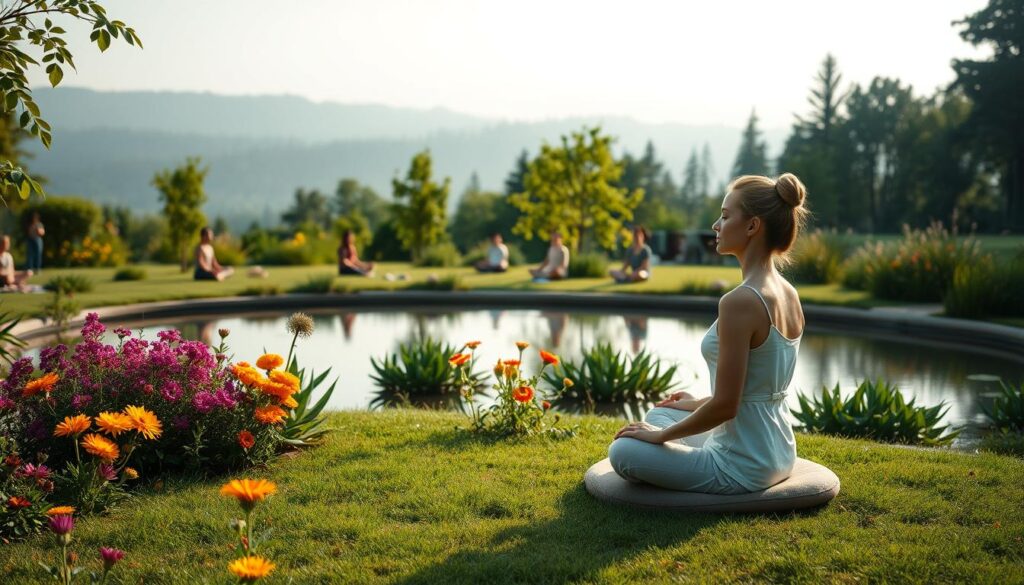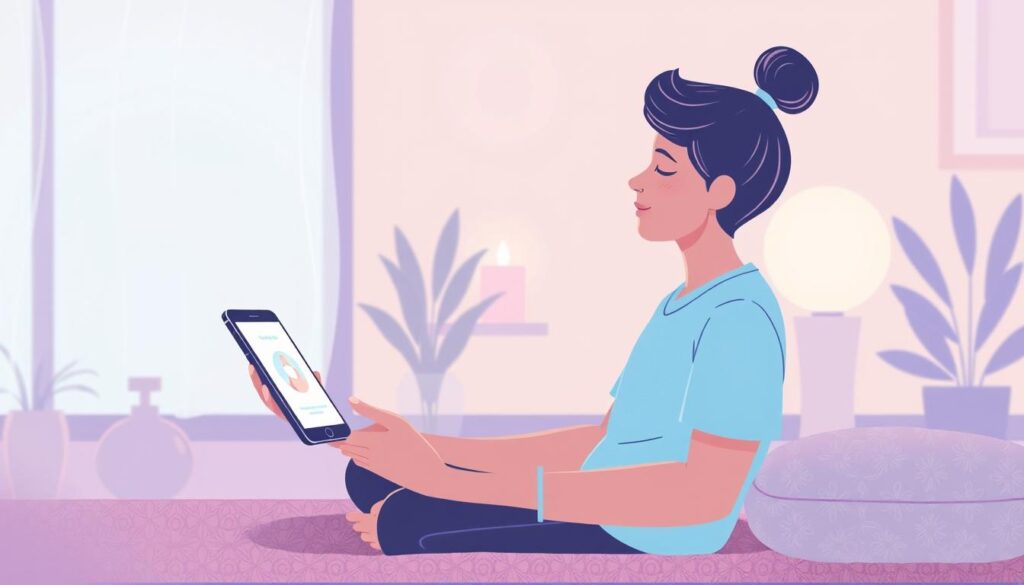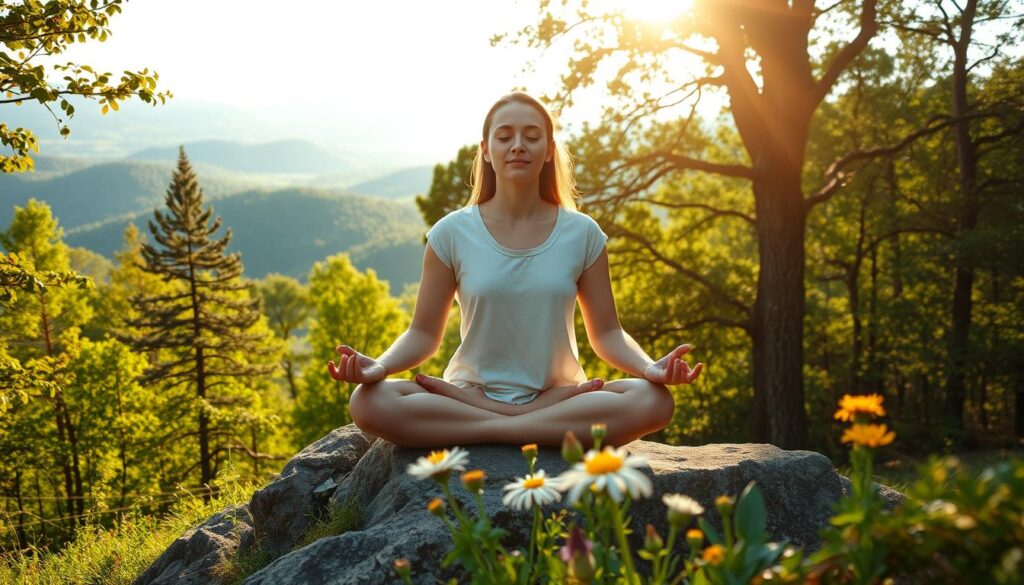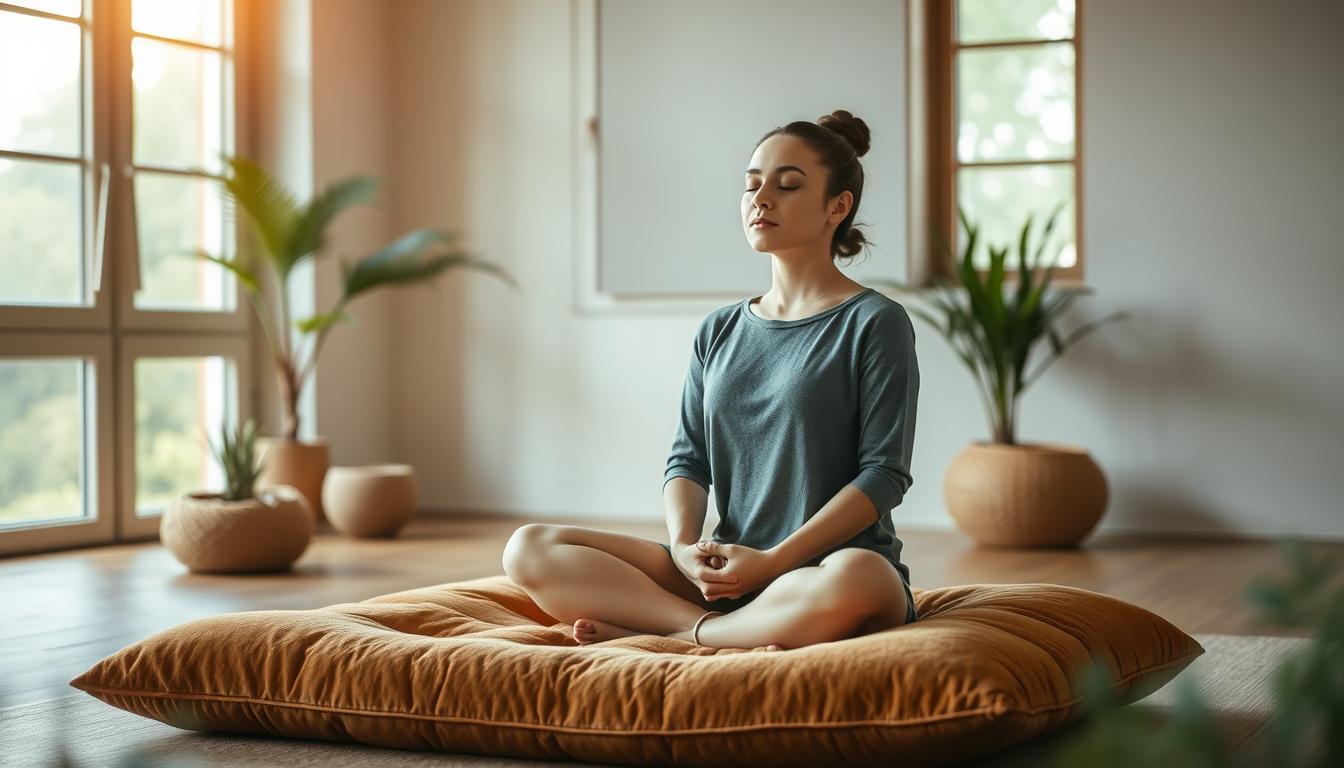I still remember the first time I tried meditation – I was struggling to relax, my mind was racing, and I felt like I couldn’t stop thinking about my to-do list. But as I started practicing mindfulness, I began to experience a sense of calm and clarity that I had never felt before.
As it turns out, I’m not alone in my quest for a calmer mind. Many of us are turning to meditation as a way to reduce stress and improve our mental wellbeing. In fact, meditation has become a popular practice for people from all walks of life, and for good reason: it is a simple, yet powerful tool for cultivating mindfulness and awareness.
As a beginner, getting started with meditation can seem daunting – but it doesn’t have to be. In this guide, we will break down the process of starting a practice into manageable steps, address common misconceptions, and explore the benefits that have made meditation so popular.
Key Takeaways
- Understand what meditation is and how it can help you reduce stress and improve mental wellbeing
- Learn how to start a meditation practice as a complete beginner
- Discover the benefits of meditation and why it’s worth sticking to the practice
- Address common misconceptions about meditation and set realistic expectations
- Find out how meditation can be a skill that anyone can learn with consistent practice
Understanding Meditation: What It Is and Why It Matters
The concept of meditation can seem mysterious, but it’s actually a simple yet profound practice that involves training your mind to focus and be present.
Meditation is often misunderstood as a relaxation technique or a way to “zone out,” but it’s more about cultivating awareness of the present moment. By doing so, you can develop a greater understanding of yourself and the world around you.
Defining Meditation in Simple Terms
Meditation is a mental training practice that involves focusing your attention while acknowledging and accepting the present moment. It’s about being mindful of your thoughts, feelings, and bodily sensations without judgment.
The Science-Backed Benefits of Regular Practice
Regular meditation practice has numerous benefits backed by research. It can reduce anxiety, improve focus, boost emotional health, deepen self-awareness, enhance sleep quality, strengthen immunity, and build mental resilience. According to neuroscientist Amishi Jha, just 12 minutes of meditation practice, 5 days a week, can protect and strengthen your ability to pay attention.
| Benefits of Meditation | Description |
|---|---|
| Reduces Stress | Helps manage stress and anxiety |
| Improves Focus | Enhances concentration and mental clarity |
| Boosts Emotional Health | Promotes emotional well-being and resilience |
By incorporating mindfulness and meditation into your daily routine, you can experience these benefits firsthand and cultivate a greater sense of calm and clarity in your life.
Getting Started with Learning Meditation
Meditation is a journey, and like any journey, it begins with the first step – creating a space and setting aside time to meditate.
For more information on how to meditate for beginners, you can visit NHS.
Let’s dive into the essential elements that will help you get started with your meditation practice.
Creating Your Meditation Space
Finding a comfortable and quiet place to meditate is crucial. You can use a cushion or pillow on the floor or sit upright in a chair, with your feet resting on the floor. The key is to create a space that is free from distractions, making it easier to focus on your meditation.
Choosing the Right Time to Meditate
The best time to meditate is whenever it is most convenient for you. Some people prefer meditating in the morning, while others prefer the evening. The important thing is to choose a time that works best with your schedule, making it easier to establish a consistent habit.
How Long Should Beginners Meditate?
As a beginner, starting with short meditation sessions of just a few minutes a day can be beneficial. A 10-minute meditation is a great starting point. The key is to be consistent and gradually increase the duration as you become more comfortable with the practice. For example, you can start with 5 minutes a day and work your way up.
Establishing a daily meditation practice can have a significant impact on your mental wellbeing. By incorporating meditation into your daily routine, you can experience the numerous benefits that come with regular practice.
The Fundamentals of Meditation Posture
The posture you adopt during meditation can significantly impact your comfort and alertness. A good meditation posture is one that allows you to be relaxed yet alert, without feeling too strained or too slouched.
Finding a Comfortable Seated Position
You don’t need to sit in a perfect lotus position to meditate. You can sit in a chair with your feet on the floor, sit loosely cross-legged on a cushion, or even kneel—whatever feels stable and comfortable for you. The key is to be in a position that you can maintain for a while without feeling too much discomfort.
Proper Alignment for Your Back, Neck, and Shoulders
Maintaining a straight back is crucial, but it shouldn’t feel forced. Keep your neck and shoulders relaxed, with your chin slightly tucked in. This alignment supports alertness without creating unnecessary tension in your body.
What to Do with Your Hands and Eyes
Your hands can be placed gently on your lap or knees, or you can form a mudra (a symbolic hand gesture) if that feels comfortable. As for your eyes, you can either close them or keep them slightly open, focusing your gaze softly ahead. Both approaches have their benefits, and it’s worth experimenting to see what works best for you.
For more guidance on how to meditate, you can visit Mindful.org, which offers a wealth of resources for beginners.
5 Basic Meditation Techniques for Beginners
Now that we’ve covered the basics of meditation, let’s dive into five basic meditation techniques that are perfect for beginners. These techniques will help you establish a strong foundation for your meditation practice and cultivate a deeper sense of mindfulness.
Breath-Focused Meditation
One of the most straightforward meditation techniques is to focus on your breath. I count each in-breath and out-breath with the same number, so my mind focuses on “One” for both the in-breath and out-breath, “Two” for the next in-breath and out-breath, and so on. If you don’t like counting, you can simply repeat to yourself “in, out… in, out…” as you breathe. This technique helps you develop focus and attention by using the breath as an anchor.
As you practice breath-focused meditation, you’ll find that it becomes easier to maintain your focus and keep your mind from wandering. This technique is a great starting point for beginners because it’s simple and easy to practice.

Body Scan Meditation
Body scan meditation involves focusing your attention on different parts of your body, starting from your toes and moving up to your head. You can spotlight one particular area or go through a sequence, paying attention to any sensations you experience. This technique helps you develop bodily awareness and can help you release tension and relax.
As you practice body scan meditation, you’ll become more aware of your body and the sensations within it. This can help you cultivate a deeper sense of relaxation and reduce stress.
Walking Meditation
Walking meditation is a great alternative for people who struggle with sitting still. To practice walking meditation, simply pay attention to your steps, noticing the sensation of your feet touching the ground. You can walk at a slow or normal pace, focusing on the movement of your body as you walk. This technique helps you cultivate mindfulness and bring meditation into your daily life.
Loving-Kindness Meditation
Loving-kindness meditation, also known as metta meditation, is a heart-centered practice that develops compassion for yourself and others. To practice loving-kindness meditation, focus on sending kind thoughts to yourself and others, using phrases such as “May I be happy, may I be healthy, may I be at peace.” This technique helps you cultivate a sense of compassion and empathy.
Guided Visualization
Guided visualization is a technique that uses imagery to create specific mental and emotional states. In this type of meditation, you’ll typically listen to a guided audio recording that leads you through a visualization exercise. This technique can help you relax, reduce stress, and cultivate a sense of well-being.
Using Guided Meditations to Enhance Your Practice
Using guided meditations can enhance your meditation practice by providing clear instructions and helping you stay focused.
As a beginner, it can be challenging to know if you’re doing meditation correctly, but guided meditations can help alleviate those doubts.

Benefits of Guided vs. Unguided Meditation
Guided meditation is particularly helpful for meditation beginners because it provides a focal point and gentle instruction, helping you connect with your meditation practice and let go of self-judgment.
In contrast, unguided meditation allows you to take full control of your practice, but it can be challenging for beginners who are unsure of what to do.
Top Apps and Resources for Guided Sessions
Some of the top apps for guided meditations include Headspace, Buddhify, and Smiling Mind – each offering a variety of guided meditation sessions tailored to different needs, such as sleep, anxiety, or focus.
These apps provide a range of resources for meditation, from beginner-friendly content to more advanced meditation practices.
What to Look for in a Meditation Guide
When choosing a guided meditation resource, consider the guide’s experience, teaching style, and voice – you want to feel comfortable and at ease during the session.
Some key qualities to look for in a meditation guide include a gentle, clear voice and a teaching style that resonates with you.
Overcoming Common Meditation Challenges
The path to mindfulness isn’t always straightforward; there are common pitfalls that many face. As you embark on your meditation journey, it’s essential to acknowledge and address these challenges to cultivate a sustainable practice.
Dealing with a Wandering Mind
One of the most significant hurdles for meditation beginners is the constant stream of thoughts that flood their mind. When your attention wanders – and it will – gently guide it back to your breath without judgment. Labeling your thoughts as “worrying” or “planning” can help you acknowledge them without getting caught up.

Managing Physical Discomfort
Physical discomfort can be a significant distraction during meditation. To manage this, try adjusting your posture or using a cushion for support. You can also experiment with different seated positions or even practice walking meditation if sitting is uncomfortable.
| Discomfort | Solution |
|---|---|
| Back pain | Use a supportive cushion or chair |
| Knee pain | Try a different seated position or use a cushion under your knees |
| Neck strain | Adjust your posture or use a neck pillow |
When “Nothing Happens” During Meditation
Sometimes, it may feel like nothing is happening during meditation, but subtle changes are often taking place. Even if you don’t feel a significant shift in your awareness or attention, you’re still cultivating mindfulness. Be patient and trust that your practice is having a positive impact, even if it’s not immediately apparent.
Conclusion: Building a Sustainable Meditation Practice
Turning meditation into a daily habit can bring about substantial changes in your life. As you continue your meditation journey, remember that it’s a lifelong practice that evolves over time. To maintain a consistent meditation practice, start with a simple 30-day plan, and be patient with yourself as you develop this new habit.
As you integrate meditation into your daily routine, you’ll find that it becomes an integral part of your life, like exercising or brushing your teeth. Research shows that it takes around 66 days for a habit to become routine, so stick to it, and you’ll start to notice subtle but significant changes over time.
Keep in mind that the goal is not to “perfect” meditation but to make it a consistent part of your daily routine. With consistent practice, you’ll experience the benefits of meditation and make it a valuable part of your life as a meditation beginners.
FAQ
How do I start a daily meditation habit?
Begin by setting aside a few minutes each day – ideally at the same time – and commit to sitting comfortably, focusing on your breath or a guided session. As you get into the habit, you can gradually increase the duration.
What is the ideal time of day to meditate?
The best time to meditate is whenever it fits into your schedule, but many people find that meditating in the morning helps set a positive tone for the day. Experiment with different times to find what works best for you.
How long should I meditate as a beginner?
Start with short sessions, even just five minutes, and gradually increase the duration as you become more comfortable with the practice. You can begin with guided meditations to help you stay focused.
What if my mind keeps wandering during meditation?
It’s normal for your mind to wander – simply acknowledge the thought and gently bring your attention back to your chosen focus, such as your breath or a guided narrative. Don’t be too hard on yourself; it’s all part of the process.
Can I meditate anywhere, or do I need a special space?
You can meditate anywhere, but having a dedicated, quiet space can be beneficial. You can sit on a cushion on the floor or in a chair – whatever feels most comfortable for you.
How can I make meditation a consistent part of my daily routine?
Incorporate meditation into your daily activities, such as right after waking up or before bed. You can also use mindfulness in daily tasks like eating or walking to help build your practice.
Are there any benefits to using guided meditations?
Guided meditations can be particularly helpful for beginners, as they provide a gentle, expert guide to help you stay focused and relaxed. They can also introduce you to various meditation techniques and help you explore different styles.
